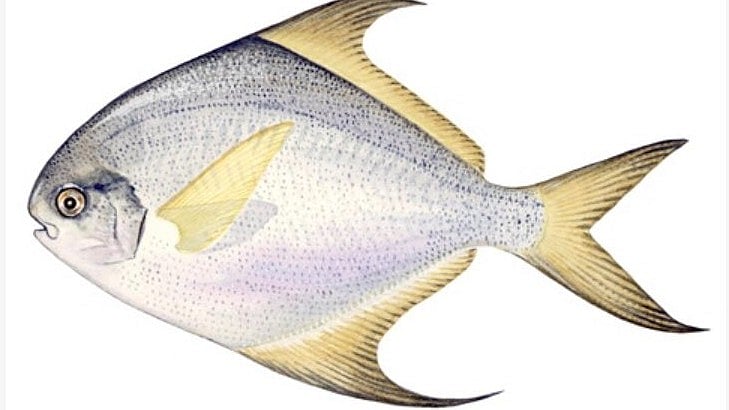Palghar: Maharashtra’s recently declared state fish, the silver pomfret (Chandheri Paplet or Saranga), is facing a critical threat of extinction due to rampant and unsustainable overfishing, particularly of juvenile fish. Fishermen and conservationists warn that the species, vital to the state’s economy and culinary heritage, could vanish if immediate action is not taken.
The silver pomfret is a globally renowned species, widely produced along Maharashtra’s coastline. However, factors such as climate change, unsustainable fishing practices, and the capture of younger fish have caused a significant decline in its numbers.
The situation has led fisher organizations to lobby for the fish’s special status, resulting in the state government declaring it as the state fish. In response, the fisheries department issued a notification for its conservation, suggesting a range of measures to protect the species. Unfortunately, the lack of effective implementation of these measures has left the pomfret facing an uncertain future.
“The indiscriminate capture of young pomfrets is preventing the species from thriving,” said a fishermen leader. “Fishermen are experiencing lower yields and higher costs, threatening their livelihoods.”
The Impact of Overfishing
Current fishing methods, characterized by the mass capture of undersized fish, are hindering the pomfret’s natural growth cycle. This has led to a significant reduction in the average size and weight of the fish caught, making it increasingly difficult for fishermen to secure commercially viable catches. Once plentiful 350-gram fish are now a rarity, replaced by 100-gram specimens struggling to survive.
Reports paint a grim picture of the pomfret’s declining production:
1980-85: Average size 350 grams, production of 20,000 tons
1990s: Average size 300 grams, production of 15,000 tons
2000-2010: Average size 200 grams, production of 12,000 tons
2010-2020: Average size 150 grams, production of 10,000 tons
The Economic Implications: A Short-Sighted Approach
While overfishing might yield short-term profits, the long-term consequences are catastrophic. The unchecked capture of juvenile pomfrets threatens the species’ very existence, jeopardizing the livelihoods of entire fishing communities. Allowing the fish to mature and reproduce naturally would yield significantly higher long-term profits, ensuring the industry’s sustainability.
Consider the economics: a 50-gram pomfret fetches a mere ₹1250 per kilogram. However, allowing it to grow for three months, reaching 250 grams, increases its market value 40-fold, to ₹1000 per kilogram, resulting in a potential earning of ₹625,000. This stark contrast highlights the economic folly of catching juvenile fish. The government must act decisively to prohibit this practice, securing both the species’ survival and the economic stability of the fishing community.
The Decline in Pomfret Size and Market Trends
Pomfrets are typically graded based on their weight, with the following classifications:
· Super: Over 500 grams
· Grade 1: 400-500 grams
· Grade 2: 300-400 grams
· Grade 3: 200-300 grams
· Grade 4: 100-200 grams
Over the years, the availability of larger, marketable fish has dwindled, with a concerning trend of smaller fish dominating the catch. In Satpati, a region known for its pomfret production, data from cooperative fishermen’s organizations has shown a significant reduction in annual production:
2018-19: 292.917 tons
2019-20: 227.213 tons
2020-21: 458.617 tons
2021-22: 223.071 tons
2022-23: 136.113 tons
Illegal Fishing Practices: A Threat to the Future
Adding to the crisis, illegal fishing practices, such as the use of purse seine nets and fishing during off-seasons, are preventing pomfrets from reaching their full size. The influx of encroaching fishermen using harmful methods further exacerbates the problem, forcing local fishermen to venture into deeper waters, increasing costs and reducing yields.
During the monsoon period, when the fish are supposed to be left undisturbed to grow, some continue to catch small fish, with no regard for the long-term impact on the population. This irresponsible fishing of juvenile fish is both an economic and ecological issue, as it not only reduces the species’ numbers but also diminishes the potential income for fishermen who rely on larger fish to make a living.
Urgent Conservation Efforts: A Call to Action
Fishermen leaders and representatives of local fishermen’s organizations are calling for urgent and comprehensive conservation efforts. This includes increased public awareness campaigns to educate fishermen and consumers about the importance of sustainable fishing practices, and the strict enforcement of conservation laws to deter illegal activities.
While fisheries department officials have assured that awareness programs are being conducted, there is a need for greater enforcement to stop illegal fishing activities and ensure compliance with fishing bans during critical breeding periods.
Conclusion: A Race Against Time
The silver pomfret’s designation as Maharashtra’s state fish should have ushered in an era of greater protection. Instead, the lack of enforcement and continued overfishing have pushed the species to the brink of extinction. Urgent measures are needed to protect this iconic fish, including stricter regulations, widespread public awareness campaigns, and the active involvement of fishermen in conservation efforts. Without immediate action, the future of Maharashtra’s state fish hangs in the balance, with potentially devastating ecological and economic consequences for the entire coastal region.
